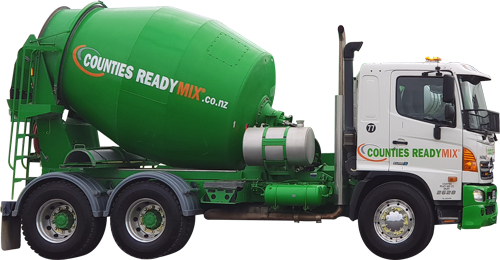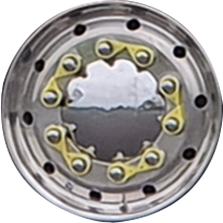



It is important to prepare the base with compacted metal such as GAP20 with a finer material to finish such as GAP7 to ensure the concrete is separated from the ground. Clay (when dry) can absorb a lot of moisture from the concrete causing cracking, the can also weaken the concrete and can easily contaminate the concrete as workers walk around the job. It is important that the base is prepared in such a way to provide a consistent thickness of concrete, variations in thickness can cause week points in the concrete and lead to cracking.
Concrete thickness should start at 100mm for residential paths, patios and light traffic driveways. The thinner the concrete the closer the joints are required and the more likely you are to have shrinkage cracking.
For driveways and patios, we recommend mesh, for paths etc.. its not really required. Mesh is typically positioned one third of the concrete thickness from the top of the slab (i.e. for a 100mm concrete thickness, mesh should be 35mm below the surface). For mesh to be effective it must be placed on bar chairs and each sheet tied together. Mesh is there to keep cracks in the concrete at a minimum width. Concrete typically cracks from the top surface (like a “V”) and when this happens the mesh prevents the crack from widening. Fibre can often be used as an alternative to mesh but it essential to get the right type of fibre, we are happy to assist with fibre specifications and provide data sheets on the products specified.
Concrete placement during summer months poses many additional challenges. Primarily the increased chance of plastic shrinkage cracking (where the concrete shrinks at the surface due to excessive moisture loss to the atmosphere causing a volume reduction in the surface of the concrete resulting in “plastic tears” in the surface). Fortunately there are many precautions that can be taken to ensure you have the best chance to reduce the likelihood of any problems.
So what can you do?
There are a few key points to remember when concreting on cold weather also. For the Auckland region we don't typically don't get the freezing conditions of the south but this short list of key points will help when concreting in colder conditions.
About 1hr for a full truck load max. When placing concrete it is important that the concrete is placed quickly (the standard specified 90 minutes from the time of batching the concrete), the hydration of cement is complicated but essentially when water is added to cement the cement begins to form crystals (or fingers) which interlock together with other cement particles providing the concrete with strength, the faster the concrete is in its final position the more opportunity for the cement particles to interlock, the stronger the concrete.
Yes, to obtain its full potential strength concrete must be vibrated, every 1% of entrapped air or voids in the concrete with potentially reduce the concrete strength by approx. 5%. Vibrators can be hired from local hire centres for little cost and it makes a big difference to the quality of the concrete. The only exception is exposed aggregate or polished concrete where vibrators aren’t used because they would alter the appearance of the finish.
Bleed water is the water that migrates to the surface of the concrete after initial placing. As the cement and aggregate particles in the concrete settle through gravity the water which is much lighter than cement or aggregates displaces to the surface of the concrete. Bleed water often appears as small puddles on the surface. This is normal and is expected on standard concretes. A lack of bleed water can indicate excessive evaporation conditions, so its a good indication as to when your concrete might be at risk of plastic settlement cracking which occurs through excessive evaporation through windy, dry low humidity conditions.
In summer 24 hours, in winter 48 hours for conventional cutting. Exposed aggregate might be left a little longer to minimize chipping
one quarter of the thickness of the concrete, 100mm thick concrete should be cut 25mm.
A tooled joint is formed in the surface of the concrete with a trowel that is shaped to create a “V” in the concrete. This causes an induced crack below the “V”. These are very good at reducing the chances of crack forming in high risk areas such as internal corners on paths, or where concrete is placed in long but narrow sections such as pathways, a 1.0 wide path could have tooled joints every 3m and not require saw cutting. Tooled joints are very effective because they are in place early, before saw cutting.
Concrete hardens because of a chemical reaction between cement and water. No water means no cement hydration. This is why its important to keep concrete wet as soon as you can without damaging the concrete surface, sprinklers are good on driveways, ponding is good on house floors. Concrete which hasn’t beed properly cured will appear white and dusty and the surface is likely to be week and prone to degradation. Concrete should be kept consistently wet for 7 days, if the concrete dries the cement hydration stops and doesn’t restart when more water is added.
Some typical ways of water curing are;
In the absence of water, a curing compound can be sprayed onto the surface of the concrete after finishing. This form a film over the concrete preventing further moisture loss. Curing compounds are never as good as water but are a good alternative where water isn’t available or isnt practical. As curing compounds leave a protective film on the surface of the concrete careful thought must be given to ensure the curing compounds don’t compromise the floor covering adhesives.
Concrete can crack through many ways such as plastic settlement, drying shrinkage, movement, creep and a few more but the most common is plastic shrinkage. Plastic shrinkage is where the concrete shrinks in the initial 6-18 hrs typically through excessive moisture loss. During hot, dry and windy conditions the concrete looses moisture through evaporation (and sometimes through the sub grade). This moisture loss results in a loss of volume or shrinkage of the concrete (think about a bath full of water, if you remove a bucket of water (evaporation), the bath water level goes down or shrinks). To reduce your risk of plastic shrinkage cracking you need to minimize the potential shrinkage (see the tips under “What do I need to consider when pouring concrete during hot & windy summer weather?”) .
It is also critical to place concrete as quickly as possible, cement gains strength by forming crystals (similar to fingers on your hand) which interlock with each other, the sooner the concrete is placed the stronger the cement particle bonds. Excessive delays on site will reduce the potential strength of the concrete and will often lead to the addition of water to the mix further reducing the concrete potential strength.
Your concrete mix has been designed with careful consideration and is regularly tested. By adding water to the mix you will weaken the concrete, make the concrete more prone to plastic shrinkage cracking, the surface is more likely to become dusty and it will take longer to set up.





©2025 Counties Ready Mix Ltd